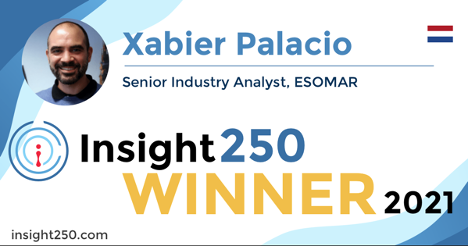Lattice of research
The importance of market context, categorisation, and the “Lattice of Research”

The Insight250 spotlights and celebrates 250 of the world’s premier leaders and innovators in market research, consumer insights, and data-driven marketing. The inaugural list was revealed last April and created renewed excitement across the industry whilst strengthening the connectivity of the market research community.
With so many exceptional professionals named to the Insight250, it seems fitting to tap into their expertise and unique perspectives across various topics. This weekly series does just that; inquiring about the expert perspectives of many of these individuals in a series of short topical features.
This edition dives into the importance of market context and categorisation within research. I sat down with Xabier Palacio, ESOMAR’s Senior Industry Analyst, to tap into his expertise and perspective on various topics. We also discuss the “Lattice of Research” he has developed to visualise methodologies across the industry.
Xabier, it is great to see you recognised as an Insight250 Winner as I’ve personally witnessed the leadership you show within our profession - could you tell ResearchWorld readers a bit more about your role?
“Thanks Crispin, and thank you for the recognition. My primary role at ESOMAR’s Intelligence Unit is twofold, with one goal to increase ESOMAR’s brand equity and authority and another to develop materials for the insights community. On the one hand, I gather intelligence and guidance to increase the association’s membership value, identify future paths of development and help ground its strategy to retain its leadership position as a guide of the industry. On the other, I coordinate the creation and dissemination of reports, studies, and other publications through written materials, articles, presentations, webinars, and, soon, podcasts. The department moved from a one-man show and a couple of reports to its current Intelligence Unit and a regular stream of publications throughout the year.”
Xabier Palacio
One of the essential things you are responsible for at ESOMAR is the Global Market Research industry report or the industry “Bible,” as some refer to it! Tell us more about that and why it is so important.
“The Global Market Research report has been produced annually since 1989. In these more than 30 years, this publication has grown to become an unmissable read for the industry’s professionals as well as one of the most valued membership benefits for ESOMAR. The report presents the size and characteristics of the insights industry at global, regional, and local levels and covers more than 105 countries and world regions. It is a fundamental read for anyone needing to understand their place within the industry and the market where they are operating. Despite its legacy name, “Global Market Research,” the report unites the entire industry, including the market research, data analysis, and reporting/advisory functions.”
Xabier Palacio
I hear that the Global Market Research report is evolving - what changes may we see in 2022/23?
“I think the most relevant change in the Global Market Research report is how the technology-enabled and reporting sectors of the insights industry have been fully embraced and now become integral parts of global turnover levels. I see this as the epitome of the recognition of the diversity and complexity of the industry. I believe it is harmful to talk about the tech-enabled sector as separate, as something distant and strange, when they compete for the same available budgets. Likewise, it is surprising to hear how certain firms that refuse to consider the tech-enabled sector as part of their competitors struggle with lower available budgets when the industry is simultaneously showing double-digit growth.
The 2022 edition of the Global Market Research report, available as of September, shows the K-shaped recovery of the industry as some countries remain diminished by the impact of the pandemic. In contrast, others successfully return to pre-pandemic levels of output. Passive, tech-enabled data collection methods, which surged in 2020, remain strong. Still, there has been a shift from secondary analysis and consultancy services (which were one of the go-to places to carry out research in a socially distanced world) to qualitative research. And despite high expected inflation rates globally, expected net growth for 2022 will still sit above 5 percent.”
Xabier Palacio
You labeled the sectors of the industry back in 2020 - why was that so important - how did you make that happen?
“Most players within the industry have always remained disenfranchised with the labeling of the sectors in the past. No one wanted to be called “traditional,” and neither the term “new” fitted the usually technological data analytics and software firms. None of the former liked the connotations of the word traditional – old-fashioned, outdated, conventional, etc. – and neither the latter felt identified with the word new – recent, small, naïve, inexperienced, etc. By using these words, the industry was growing more distant, and more fractured; that is, potentially weaker.
“A proposal was put forward to the Sounding Board of the 2020 edition of the Global Market Research report: to break the dichotomy (avoid using opposites) and highlight instead what made each sector unique. “Established,” therefore, focuses on long-standing, proven, time-honoured aspects. “Tech-enabled,” on the other hand, shows what could not have happened without the advent of technology. Highlighting the unique and positive side of each sector has dramatically reduced the alienation of companies and has also helped unite the two. We still receive plenty of messages from companies resenting being called “traditional” – which is something we have never done explicitly and which allusions, if any, we stopped completely in 2020, which shows that there is still quite some awareness work ahead of us.”
Xabier Palacio
The wide distribution of the Top-50 report has embedded the sector breakdown you developed (established, tech-enabled, and reporting) - how did you come up with the idea for the Top-50 report and how do you think it will develop over time?
“As the Intelligence Unit developed, it became clear that the Global Market Research report was trying to include too much information in its pages. It made sense when it was ESOMAR’s primary publication, but now it risked diluting the report by making its contents less clear for the user. By including everything, it became more difficult to highlight the relevant information.
“Secondly, we wanted to make more information available to the community at no cost. The industry always looked up to the US ranking created by Honomichl and, while we had always published the Global Top-50 in the pages of the Global Market Research report, its level of awareness was rather limited.
“Producing the raking as a standalone publication allowed me to delve in much more detail on the relationship between the top companies and the current and future states of the industry.
The huge success of ESOMAR’s Global Top-50 Insights Companies showed the interest of the community in learning more about this. Future reports will continue to build on each other and help create a legacy that helps highlight which companies are making a change in the industry.”
Xabier Palacio
You also developed the “Lattice of Research” categorisation - tell us more about that concept?
“The lattice of research is a visualisation of types of methodology. The primary goal was to recognise the compatibility of methods utilised by the established and the tech-enabled sectors within the familiar framework of quantitative/qualitative, and active/passive methods. This three-axis composition shows the unification of the industry at a glance and should convince skeptics of the common arena everyone is playing in.
“By showing visually the natural place these technological methods of data collection occupy, we can begin a much more convincing conversation to bring these companies to our fold with several benefits: better understanding these industrial segments, starting a discussion on areas of self-regulation that the established industry has been respecting for over 70 years, and reversing the schism between the two sectors so they can start enjoying common synergies.
“Grounding complex concepts on simple visualisations that the community can grasp has been hugely effective, and it also simplifies language because we are giving specific meaning to the terms. Now we can say that active qualitative tech-enabled methods (such as online research communities) are globally nearly as common as active qualitative established ones (focus groups or in-depth F2F) without further detours.
“I should extend a cautionary comment at this point, as there is a common misconception that the established sector focuses on established methods, and likewise with the tech-enabled one. While this was the case back in the day, this is no longer true. The democratisation of data collection has broken this link. Any company can deploy either type of collection method, because data collection is no longer the primary descriptor of companies, and because data collection is no longer the main driver for cost at companies.”
Xabier Palacio
How do you think this industry categorisation will evolve?
“It will certainly evolve, and quickly. I can imagine a near future in which the increased technological development of all companies makes the established/tech-enabled categorisation obsolete (as well as the qualitative/quantitative one). I could imagine a future categorisation that focuses less on the data collection activity – when it is so democratised that it becomes trivial – and more on the business process behind the insights. Perhaps the future asks for a new distinction between project-based companies with full-cycle services from collection to reporting, organised in tender competitions and with unified quotes, and single-service ones offering specific platforms, audiences and portions of the insights cycle that they can utilise as they deem appropriate. Of course, this is highly speculative, time will tell where this all goes!”
Xabier Palacio
As you continue to champion an understanding of our industry what innovations can we expect in the future?
“I constantly hear about further increases in the technological capabilities of companies, and I see huge amounts of investment being poured over some areas such as self-serve platforms. But I think these are relatively short-term assessments. In my view, there are two areas where the industry can move.
“I find that there is an area of the industry which is heavily consolidated. This is the full-service, project-based, tender-and-quote, industry. These large-scale, A to Z projects will continue in the future. Think of polling or certain projects of market measurement. And then there are these agile, hugely specific platforms for the collection, analysis, and research design, all of them unique, useful in their own way, and largely independent from each other. These two will live side-by-side, and they will serve different needs. I believe today we are witnessing the progressive consolidation of this second type (hence its high levels of growth) and will come to form a parallel sector. Technology will cease to be a defining feature.
“And lastly is the added value of the reporting phase. Presenting a simple PowerPoint of descriptive statistics as the deliverables will quickly become insufficient. And providing proper business support at no cost will likewise make no sense. As companies realise the true added value of their consultancy and advisory services, they will be able to capitalise on what in my view is the last bastion of democratisation. I think this is the place where the highest added value will lie once data analysis becomes trivialised, since it is no longer in data collection.”
Xabier Palacio
We have long talked as a profession about embracing our peers in the “data” community - what are you and ESOMAR doing in this space and why is it so important?
“In brief, we need the data community to uphold the same level of professional standards that the market research industry has been curating and respecting for the past 75 years. That is imperative to protect not only the individual but also the industry itself. There are only a limited number of Cambridge Analytica scandals the industry can endure before losing the credibility it has long upheld.
“Companies also need to leverage the competitive advantage that merging data analysis with insights extraction will create. If you don’t know your competition, it is much more difficult to identify these synergies.
“ESOMAR is currently involved in the International Data Management Study to identify, talk to, bring closer, and welcome, data science professionals and companies. To continue to help the entire industry.”
Xabier Palacio
TOP TIP
“Looking away from inevitable change won’t make it go away. Don’t ignore your competition just because it looks radically different from what you knew. Learn from them!
Xabier Palacio
While the complexity of research methodologies and applications continue to expand, experts like Xabier are simplifying complex concepts through visualisations that the research industry can easily understand. While simple in concept, this process is becoming increasingly essential to researchers in order to have the industry speak the same language so it can advance forward, facilitating innovation across technology, methodology and delivery. Thank you Xabier - both for this fascinating perspective but also fo all your hard work and leadership at ESOMAR which helps drive innovation in our profession.
 Xabier Palacio has guided and coordinated the creation of studies, reports, and other publications at ESOMAR’s Intelligence Unit since 2018. He holds two MSc in International Economics and Marketing from the Erasmus University of Rotterdam in The Netherlands. Some of the most representative materials produced by his department include the Global Market Research report, one of ESOMAR’s most highly regarded member benefits, the Global Prices Study, the Evolution of the Data, Analytics and Insights Industry or ESOMAR’s
Global Top-50 Insights Companies ranking.
Xabier Palacio has guided and coordinated the creation of studies, reports, and other publications at ESOMAR’s Intelligence Unit since 2018. He holds two MSc in International Economics and Marketing from the Erasmus University of Rotterdam in The Netherlands. Some of the most representative materials produced by his department include the Global Market Research report, one of ESOMAR’s most highly regarded member benefits, the Global Prices Study, the Evolution of the Data, Analytics and Insights Industry or ESOMAR’s
Global Top-50 Insights Companies ranking.
Crispin Beale
Chairman at QuMind, CEO at Insight250, Senior Strategic Advisor at mTab, CEO at IDXCrispin Beale is a marketing, data and customer experience expert. Crispin spent over a decade on the Executive Management Board of Chime Communications as Group CEO of leading brands such as Opinion Leader, Brand Democracy, Facts International and Watermelon. Prior to this Crispin held senior marketing and insight roles at BT, Royal Mail Group and Dixons. Crispin originally qualified as a chartered accountant and moved into management consultancy with Coopers & Lybrand (PwC). Crispin has been a Board Director (and Chairman) of the MRS for nearly 20 years and UK ESOMAR Representative for c15 years. As well as being CEO of Insight250, Crispin is currently Worldwide CEO of Digital Communications Solution Agency, IDX. Crispin is also the Senior Strategic Advisor at mTab and the Chairman of QuMind and spent 4 years as Group President of Behaviorally where he was responsibile for the client & commercial teams globally. Crispin is a passionate advocate for blending human intelligence and technology to deliver innovation and leadership across organisations.


